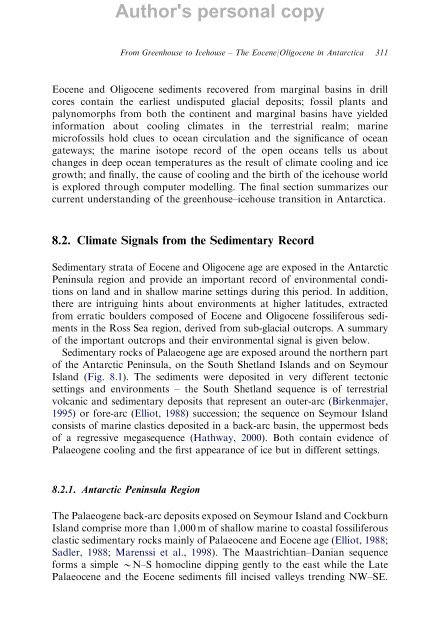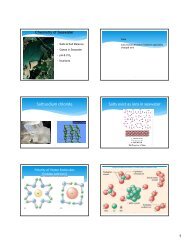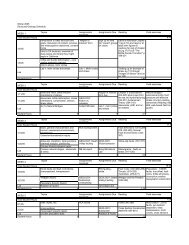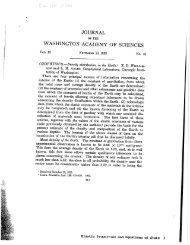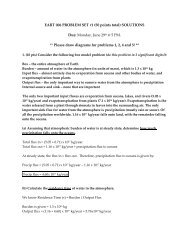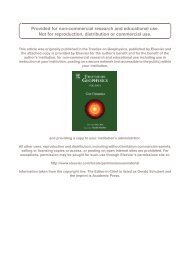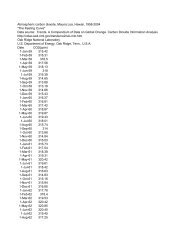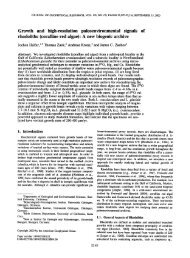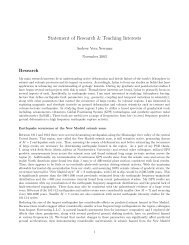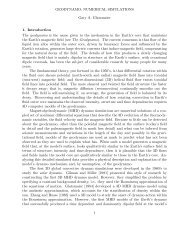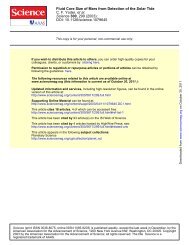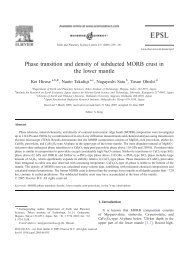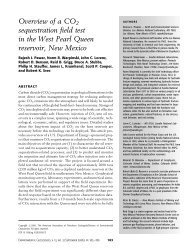From Greenhouse to Icehouse – The Eocene/Oligocene - UMass ...
From Greenhouse to Icehouse – The Eocene/Oligocene - UMass ...
From Greenhouse to Icehouse – The Eocene/Oligocene - UMass ...
You also want an ePaper? Increase the reach of your titles
YUMPU automatically turns print PDFs into web optimized ePapers that Google loves.
Author's personal copy<br />
<strong>From</strong> <strong>Greenhouse</strong> <strong>to</strong> <strong>Icehouse</strong> <strong>–</strong> <strong>The</strong> <strong>Eocene</strong>/<strong>Oligocene</strong> in Antarctica 311<br />
<strong>Eocene</strong> and <strong>Oligocene</strong> sediments recovered from marginal basins in drill<br />
cores contain the earliest undisputed glacial deposits; fossil plants and<br />
palynomorphs from both the continent and marginal basins have yielded<br />
information about cooling climates in the terrestrial realm; marine<br />
microfossils hold clues <strong>to</strong> ocean circulation and the significance of ocean<br />
gateways; the marine iso<strong>to</strong>pe record of the open oceans tells us about<br />
changes in deep ocean temperatures as the result of climate cooling and ice<br />
growth; and finally, the cause of cooling and the birth of the icehouse world<br />
is explored through computer modelling. <strong>The</strong> final section summarizes our<br />
current understanding of the greenhouse<strong>–</strong>icehouse transition in Antarctica.<br />
8.2. Climate Signals from the Sedimentary Record<br />
Sedimentary strata of <strong>Eocene</strong> and <strong>Oligocene</strong> age are exposed in the Antarctic<br />
Peninsula region and provide an important record of environmental conditions<br />
on land and in shallow marine settings during this period. In addition,<br />
there are intriguing hints about environments at higher latitudes, extracted<br />
from erratic boulders composed of <strong>Eocene</strong> and <strong>Oligocene</strong> fossiliferous sediments<br />
in the Ross Sea region, derived from sub-glacial outcrops. A summary<br />
of the important outcrops and their environmental signal is given below.<br />
Sedimentary rocks of Palaeogene age are exposed around the northern part<br />
of the Antarctic Peninsula, on the South Shetland Islands and on Seymour<br />
Island (Fig. 8.1). <strong>The</strong> sediments were deposited in very different tec<strong>to</strong>nic<br />
settings and environments <strong>–</strong> the South Shetland sequence is of terrestrial<br />
volcanic and sedimentary deposits that represent an outer-arc (Birkenmajer,<br />
1995) orfore-arc(Elliot, 1988) succession; the sequence on Seymour Island<br />
consists of marine clastics deposited in a back-arc basin, the uppermost beds<br />
of a regressive megasequence (Hathway, 2000). Both contain evidence of<br />
Palaeogene cooling and the first appearance of ice but in different settings.<br />
8.2.1. Antarctic Peninsula Region<br />
<strong>The</strong> Palaeogene back-arc deposits exposed on Seymour Island and Cockburn<br />
Island comprise more than 1,000 m of shallow marine <strong>to</strong> coastal fossiliferous<br />
clastic sedimentary rocks mainly of Palaeocene and <strong>Eocene</strong> age (Elliot, 1988;<br />
Sadler, 1988; Marenssi et al., 1998). <strong>The</strong> Maastrichtian<strong>–</strong>Danian sequence<br />
forms a simple BN<strong>–</strong>S homocline dipping gently <strong>to</strong> the east while the Late<br />
Palaeocene and the <strong>Eocene</strong> sediments fill incised valleys trending NW<strong>–</strong>SE.


